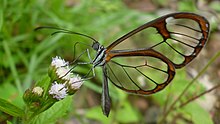| Pseudoscada erruca | |
|---|---|

| |
| Scientific classification | |
| Domain: | Eukaryota |
| Kingdom: | Animalia |
| Phylum: | Arthropoda |
| Class: | Insecta |
| Order: | Lepidoptera |
| Family: | Nymphalidae |
| Genus: | Pseudoscada |
| Species: | P. erruca |
| Binomial name | |
| Pseudoscada erruca (Hewitson, 1855) | |
| Synonyms | |
| |
Pseudoscada erruca is a South-American species of brush-footed butterfly in the Godyridina subtribe of Ithomiini. It was described in 1855 by William Chapman Hewitson as Ithomia erruca.
Distribution and habitat
The type locality of Pseudoscada erruca is Rio Grande do Sul in Brazil. It also occurs in other parts of Brazil, such as Pernambuco, and in Argentina.
Pseudoscada erruca occurs in humid habitats with a permanent presence of water. Research in 2009 on the frequency of occurrence of species in tribe Ithomiini in old-growth tropical forest versus nearby fragmented landscapes found that the presence of P. erruca was more frequent in the latter than the former.
Behaviour
Females deposit individual eggs on the underside of leaves of Sessea brasiliensis and less commonly Cestrum spp., with a preference for plants at a height between 1 and 1.5 m in shaded spots. Larvae feed from the leaves of the plant on which they hatch, generally developing better on S. brasiliensis than on Cestrum species. Adults drink nectar, with a preference for the flowers of Rubus rosaefolius. Adults of P. erruca are on wing in both dry and rainy seasons.
Parasitoids
Pseudoscapa erruca is host to multiple species of parasitoid wasps, with at least one species each from genera Telenomus, Trichogramma, Diadegma and Mesochorus. It has also been found parasitized by a tachinid fly species.
Footnotes and references
Footnotes
- per the research, these landscapes consist of "a matrix mostly made up of small farms and orchards, mixed with vegetation in initial stages of regeneration (2 to 8 years) and reforestation with exotic eucalyptus and pine interspersed with about 35% native vegetation"
References
- ^ Savela, Markku. "Pseudoscada". Lepidoptera and some other life forms. Retrieved 8 July 2018.
- ^ De Abreu, Verediana (2019). História natural e dinâmica populacional dos imaturos de Pseudoscada erruca (Nymphalidae: Ithomiini) e seus parasitoides em sua planta hospedeira Sessea brasiliensis (Solanaceae) [Natural history and population dynamics of immature stages of Pseudoscada erruca (Nymphalidae: Ithomiini) and their parasitoids on host plant Sessea brasiliensis (Solanaceae)] (PDF) (Master in Ecology) (in Portuguese). Instituto de Biologia da Universidade Estadual de Campinas. Retrieved 1 September 2022.
- ^ Beccaloni, G.; Scoble, M.; Kitching, I.; Simonsen, T.; Robinson, G.; Pitkin, B.; Hine, A.; Lyal, C., eds. (2003). "Pseudoscada erruca". The Global Lepidoptera Names Index. Natural History Museum. Retrieved 8 July 2018.

- ^ Nobre, Carlos Eduardo B.; Schlindwein, Clemens; Mielke, Olaf H. (16 April 2008). "The butterflies (Lepidoptera: Papilionoidea and Hesperioidea) of the Catimbau National Park, Pernambuco, Brazil". Zootaxa. 1751 (1): 35. doi:10.11646/zootaxa.1751.1.3. Retrieved 1 September 2022.
- ^ Uehara-Prado, Marcio; Freitas, André V.L. (February 2009). "The effect of rainforest fragmentation on species diversity and mimicry ring composition of ithomiine butterflies". Insect Conservation and Diversity. 2 (1): 24–25. doi:10.1111/j.1752-4598.2008.00025.x. S2CID 84850702. Retrieved 1 September 2022.
- Freitas, AVL (1996). "Population biology of Heterosais edessa(Nymphalidae) and its associated Atlantic forest Ithomiinae community". Journal of the Lepidopterists' Society. 50 (4): 279–284. Retrieved 1 September 2022.
| Taxon identifiers | |
|---|---|
| Pseudoscada erruca | |
This Danainae article is a stub. You can help Misplaced Pages by expanding it. |